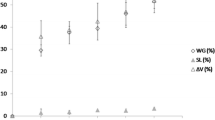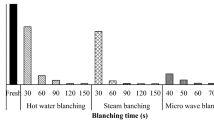Abstract
The objectives of the present work were to optimise watercress heat and thermosonication blanching conditions, in order to obtain a product with better quality for further freezing, and to evaluate the effects of thermosonication on the microstructure of watercress leaves. In a chart of optimal time–temperature conditions for a 90% peroxidase inactivation (imposed constraint), vitamin C (objective function) and a-value (improvement toward green) were mathematically predicted for both heat and thermosonication blanching treatments. Two optimal thermosonication combinations were selected: 92 °C and 2 s, retaining 95% of vitamin C content and 5% a-value improvement, and a better condition in terms of practical feasibility, 86 °C and 30 s, allowing a 75% vitamin C retention and 8% a-value improvement. The experimental values, for each thermosonication optimal time–temperature zone, were in good agreement with the models' predicted responses. In terms of microstructure, thermosonicated watercress at 86 and 92 °C showed similar loss of turgor and release of chloroplasts. The proposed optimal thermosonication blanching conditions allow the improvement of the blanched watercress quality and consequently contribute for the development of a high-quality new frozen product. However, a suitable scale-up is mandatory for industrial implementation.






Similar content being viewed by others
Abbreviations
- a :
-
Colour co-ordinate, represents red to green in the Hunter Lab colour space
- C :
-
Value or concentration of the dependent variable (peroxidase activity, colour or vitamin C)
- E a :
-
Activation energy (kJ mol−1)
- k :
-
Reaction rate constant (min−1)
- fw:
-
Fresh weight
- e:
-
Value at equilibrium
- 0:
-
Initial value at time equal to zero
- 1:
-
Relative to heat-labile enzyme fraction
- 2:
-
Relative to heat-resistant enzyme fraction
- 84.6 °C:
-
At the reference temperature of 84.6 °C
- 87.5 °C:
-
At the reference temperature of 87.5 °C
References
Agüero, M. V., Ansorena, M. R., Roura, S. I., & del Valle, C. E. (2008). Thermal inactivation of peroxidase during blanching of butternut squash. LWT-Food Science and Technology, 41, 401–407.
Allali, H., Marchal, L., & Vorobiev, E. (2008) Blanching of strawberries by ohmic heating: Effects on the kinetics of mass transfer during osmotic dehydration. Food and Bioprocess Technology. doi:10.1007/s11947-008-0115-5.
Bahçeci, K. S., Serpen, A., Gökmen, V., & Acar, J. (2005). Study of lipoxygenase and peroxidase as indicator enzymes in green beans: change of enzyme activity, ascorbic acid and chlorophylls during frozen storage. Journal of Food Engineering, 66(2), 187–192.
Banga, J. R., Perez-Martin, R. I., Gallardo, J. M., & Casares, J. J. (1991). Optimization of the thermal processing of conduction-heated canned foods: study of several objective functions. Journal of Food Engineering, 14, 25–51.
Bowers, J. (1992). Food theory and applications (pp. 738–739). New York: Macmillan.
Cruz, R. M. S., Vieira, M. C., & Silva, C. L. M. (2006). Effect of heat and thermosonication treatments on peroxidase inactivation kinetics in watercress (Nasturtium officinale). Journal of Food Engineering, 72(1), 8–15.
Cruz, R. M. S., Vieira, M. C., & Silva, C. L. M. (2007). Modelling kinetics of watercress (Nasturtium officinale) colour changes due to heat and thermosonication treatments. Innovative Food Science & Emerging Technologies, 8, 244–252.
Cruz, R. M. S., Vieira, M. C., & Silva, C. L. M. (2008). Effect of heat and thermosonication treatments on watercress (Nasturtium officinale) vitamin C degradation kinetics. Innovative Food Science & Emerging Technologies, 9, 483–488.
Fonseca, S. C., Silva, C. L., & Malcata, F. X. (2005). Microstructural analysis of fresh-cut red bell pepper (Capsicum annuum L.) for postharvest quality optimization. Electronic Journal of Environmental, Agricultural and Food Chemistry, 4(5), 1081–1085.
Grandison, A. S. (2006). Postharvest handling and preparation of foods for processing. In J. G. Brennan (Ed.), Food processing handbook. Weinheim: Wiley-VCH Verlag.
Holdsworth, S. D. (1985). Optimisation of thermal processing—A review. Journal of Food Engineering, 4, 89–116.
Jha, S. N., & Prasad, S. (1996). Determination of processing conditions on gorgon nut (Euryale ferox). Journal of Agricultural Engineering Research, 63(2), 103–112.
Kerr, W. L. (2004). Texture in frozen foods. In C. Hui, L. Legaretta & N. Murrell (Eds.), Handbook of frozen foods (pp. 149–150). New York: Marcel Dekker.
Knorr, D., Zenker, M., Heinz, V., & Lee, D. (2004). Applications and potential of ultrasonics in food processing. Trends in Food Science & Technology, 15, 261–266.
Kunzek, H., Kabbert, R., & Gloyna, D. (1999). Aspects of material science in food processing: Changes in plant cell walls of fruits and vegetables. Zeitschrift für Lebensmittel untersuchung und-Forschung A, 208, 233–250.
Lemos, M. A., Oliveira, J. C., & Saraiva, J. A. (2000). Influence of pH on the thermal inactivation kinetics of horseradish peroxidase in aqueous solution. LWT-Food Science and Technology, 33, 362–368.
Mason, T. G., Paniwnyk, L., & Lorimer, J. P. (1996). The uses of ultrasound in food technology. Ultrasonics Sonochemistry, 3, 253–260.
Mountney, G. J., & Gould, W. A. (1988). Low-temperature food preservation. In G. Mountney (Ed.), Practical food microbiology and technology (pp. 112–115). New York: Van Nostrand Reinhold.
Murcia, M. A., López-Ayerra, B., Martinez-Tomé, M., Vera, A. M., & García-Carmona, F. (2000). Evolution of ascorbic acid and peroxidase during industrial processing of broccoli. Journal of the Science of Food and Agriculture, 80, 1882–1886.
Pala, M. (1983). Effect of different pretreatments on the quality of deep frozen green beans and carrots. International Journal of Refrigeration, 6, 237–246.
Pizzocaro, F., Senesi, E., Querro, O., & Gasparoli, A. (1995). Blanching effect on carrots. Study of the lipids stability during the frozen conservation. Industrie Alimentari, 34, 1265–1272.
Préstamo, G., & Arroyo, G. (1998). High hydrostatic pressure effects on vegetable structure. Journal of Food Science, 63(5), 1–4.
Quintero-Ramos, A., Bourne, M. C., Barnard, J., & Anzaldúa-Morales, A. (1998). Optimization of low temperature blanching of frozen jalapeño pepper (Capsicum annuum) using response surface methodology. Journal of Food Science, 63(3), 519–522.
Raso, J., & Barbosa-Cánovas, G. V. (2003). Nonthermal preservation of foods using combined processing techniques. Critical Reviews in Food Science and Nutrition, 43(3), 265–285.
Saguy, I., & Karel, M. (1979). Optimal retort temperature profile in optimizing thiamin retention in conduction-type heating of canned foods. Journal of Food Science, 44(5), 1485–1490.
Teixeira, A. A., & Shoemaker, C. F. (1989). Process optimization. In S. Teixeira (Ed.), Computerized food processing operations (pp. 169–170). New York: Van Nostrand Reinhold.
Tiwari, B. K., O' Donnell, C. P., Muthukumarappan, K., & Cullen, P. J. (2009). Ascorbic acid degradation kinetics of sonicated orange juice during storage and comparison with thermally pasteurised juice. LWT-Food Science and Technology, 42, 700–704.
Vercet, A., Burgos, J., Crelier, S., & López-Buesa, P. (2001). Inactivation of proteases and lipases by ultrasound. Innovative Food Science & Emerging Technologies, 2, 139–150.
Walkling-Ribeiro, M., Noci, F., Riener, J., Cronin, D. A., Lyng, J. G., & Morgan, D. J. (2007). The Impact of thermosonication and pulsed electric fields on Staphylococcus aureus inactivation and selected quality parameters in orange juice. Food and Bioprocess Technology, . doi:10.1007/s11947-007-0045-7.
Zapata, S., & Dufour, J. (1992). Ascorbic, dehydroascorbic and isoascorbic acid simultaneous determinations by reverse phase ion interaction HPLC. Journal of Food Science, 57(2), 506–511.
Acknowledgments
The author Rui M. S. Cruz gratefully acknowledges his Ph.D. grant SFRH/BD/9172/2002 to Fundação para a Ciência e a Tecnologia (FCT) from Ministério da Ciência e do Ensino Superior. The authors thank the Vitacress Company for supplying the raw watercress.
Author information
Authors and Affiliations
Corresponding author
Rights and permissions
About this article
Cite this article
Cruz, R.M.S., Vieira, M.C., Fonseca, S.C. et al. Impact of Thermal Blanching and Thermosonication Treatments on Watercress (Nasturtium officinale) Quality: Thermosonication Process Optimisation and Microstructure Evaluation. Food Bioprocess Technol 4, 1197–1204 (2011). https://doi.org/10.1007/s11947-009-0220-0
Received:
Accepted:
Published:
Issue Date:
DOI: https://doi.org/10.1007/s11947-009-0220-0




